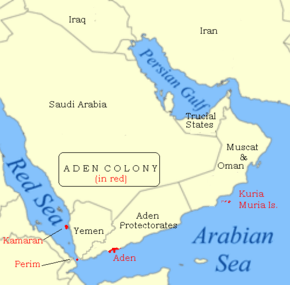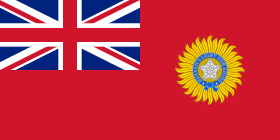Aden Province
| Aden Settlement (1839 - 1932) Aden Province (1932 - 1937) إقليم عدن | |||||
| Province of British India | |||||
| |||||
|
Flag | |||||
 | |||||
| Capital | Aden | ||||
| History | |||||
| • | Occuppied by the British | 19 January 1839 | |||
| • | Established as the Colony of Aden | 1937 | |||
| Area | 192 km2 (74 sq mi) | ||||
Part of a series on the |
|---|
| History of Yemen |
 |
| Timeline |
| Yemen portal |
.jpg)

Aden, essentially the port of Aden, was governed and organized as a Province of the British India between 1839 and 1937, while physically located on the southern Arabian Peninsula. Aden had been governed since September 1839 as the Aden Settlement, a 'Non-Regulation Province'[1] subordinated to the Bombay Presidency,[2] and then as a 'Regulation Province' governed by a chief commissioner appointed by the Governor-General of India.
After British occupation Aden soon became an important transit port and coaling station for trade between Europe, India and the Far East. The commercial and strategic importance of Aden increased considerably after the Red Sea was surveyed and the Suez Canal opened in 1869. From then and until the 1960s, the Port of Aden was to be one of the busiest ship-bunkering, duty-free shopping, and trading ports in the world.[3] Later, British influence would extend progressively into the vast hinterland and, by the early 1900s, the British Government of India began to refer to the nine protectorates neighbouring Aden Settlement, consisting of South Arabia and the Aden Residency, as the 'Aden Protectorate'.[4] Aden was to remain under British control until 1967.
Under the Government of India Act 1935 the territory was detached from British India and was re-organised as a separate Crown Colony of the United Kingdom, the Colony of Aden; this separation took effect on 1 April 1937.
History
Under British rule Aden was governed as the 'Aden Settlement' after occupation. It was placed under the Bombay Presidency and all foreign affairs were conducted through the Indian Political Service (IPS), being treated in practice as if it was a province of British India. However, the actual status of a regulation province governed by a chief commissioner appointed by the Governor-General of India was granted to Aden only in 1932 when the administration of Aden was transferred to the government of India in Delhi.[4]
Historical background
In 1609 The Ascension was the first English ship to visit Aden, before sailing on to Mocha during the Fourth voyage of the East India Company.[5]
After Ottoman rule, Aden was ruled by the Sultanate of Lahej, under suzerainty of the Zaidi imams of Yemen.
Aden was at this time a small village with a population of 600 Arabs, Somalis, Jews and Indians—housed for the most part in huts of reed matting erected among ruins recalling a vanished era of wealth and prosperity. Then Captain Frederick Haines stated that it could become a major trading centre and the latter part of the British period proved him correct with Aden growing to become one of the busiest ports in the world. In 1838, under Muhsin bin Fadl, Lahej ceded 194 km² (75 sq. miles) including Aden to the British.
British rule
On 19 January 1839, the British East India Company landed the Royal Marines of the 24th Regiment of Bombay Native Infantry at Aden who stormed and captured the city. The British secured the territory for its strategic importance because of its location on the main British shipping route to India. Aden port lies about equidistant from the Suez Canal, Mumbai, and Zanzibar, which were all important British possessions. Traditionally Aden had been an entrepôt and a way-station for seafarers since ancient times where supplies, particularly water, were replenished. In the mid-19th century it became necessary to replenish coal and boiler water. Thus Aden acquired a coaling station at Steamer Point. The British Armed Forces also considered Aden an important place due to its location, as the Royal Navy could easily access the port at Aden for fueling purposes.[6]
The Aden Settlement consisted of the port city of Aden and its immediate surroundings, an area of 192 km², 75 sq. miles. The original territory of the Aden Settlement was enlarged in 1857 by the annexation of the 13 km² outlying island of Perim, in 1868 by the 73 km² Khuriya Muriya Islands, and in 1915 by the island of Kamaran, a quarantine station for Muslims on the pilgrimage to Mecca that was under Ottoman rule. The British captured Kamaran in 1915 and, since they could not come to an agreement with the Imam of Yemen who claimed the island, they became the de facto rulers continuing to occupy the 108 km2 (42 sq mi) island without a clear title to it.
The Aden Brigade of the British Indian Army based in Aden was formed after 1903 and the Kitchener Reforms. British representatives were appointed from British India until 1917 when the Indian Political Service relinquished control and the Aden Settlement, together with the Aden Protectorate, became the responsibility of the Foreign Office in London.[4] In 1932 Aden was made a province of British India in its own right.
In 1937 Aden was separated from British India and was transferred to the Colonial Office as a Crown Colony, a status that it retained until 1963.
Chief Commissioners
For previous British ruling officers see List of British representatives at Aden
- Sir Bernard Rawdon Reilly, first as resident in 1931, then as Chief Commissioner.[7]
Views of Aden
 The Aden crescent in 1931. |
 Esplanade Road in the late 1930s. |
Sir Bernard Rawdon Reilly (3d from left in the front row), the chief British official of Aden, at a meeting in Lahej; circa 1928-1930. |
See also
- Postage stamps and postal history of Aden
- Aden Protectorate
- Baloch Regiment
- Territorial evolution of the British Empire
- Robert Moresby (Survey of the Red Sea)
References
- ↑ The land systems of British India
- ↑ Provinces of British India
- ↑ British-Yemeni Society: The development of the Port of Aden
- 1 2 3 James Onley, The Raj Reconsidered: British India’s Informal Empire and Spheres of Influence in Asia and Africa (2009)
- ↑ J. K. Laughton, ‘John Jourdain (c.1572–1619)’, rev. H. V. Bowen, Oxford Dictionary of National Biography, Oxford University Press, 2004; online edn, Jan 2008
- ↑ "Port of Aden from the Sea". World Digital Library. December 1894. Retrieved 2013-06-11.
- ↑ Sir Bernard Rawdon Reilly - The British Empire
External links
 Media related to Aden in the 19th century at Wikimedia Commons
Media related to Aden in the 19th century at Wikimedia Commons
| Wikisource has the text of the 1911 Encyclopædia Britannica article Aden. |
| ||||||||||||||
Coordinates: 12°48′N 45°02′E / 12.800°N 45.033°E
